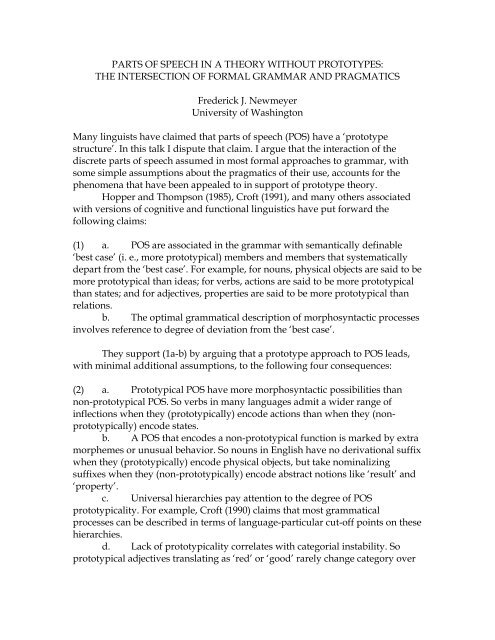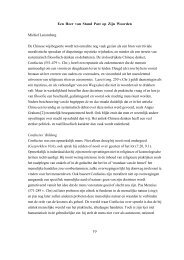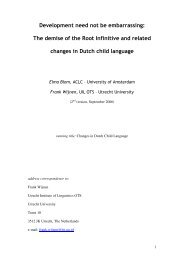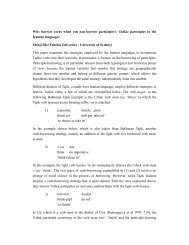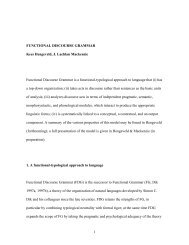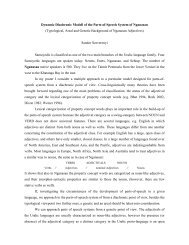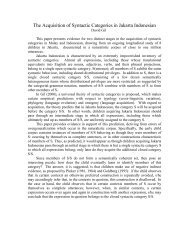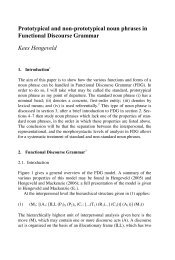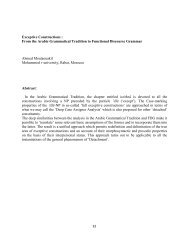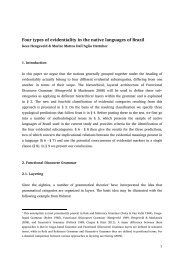The Intersection of formal grammar and pragmatics
The Intersection of formal grammar and pragmatics
The Intersection of formal grammar and pragmatics
You also want an ePaper? Increase the reach of your titles
YUMPU automatically turns print PDFs into web optimized ePapers that Google loves.
PARTS OF SPEECH IN A THEORY WITHOUT PROTOTYPES:<br />
THE INTERSECTION OF FORMAL GRAMMAR AND PRAGMATICS<br />
Frederick J. Newmeyer<br />
University <strong>of</strong> Washington<br />
Many linguists have claimed that parts <strong>of</strong> speech (POS) have a ‘prototype<br />
structure’. In this talk I dispute that claim. I argue that the interaction <strong>of</strong> the<br />
discrete parts <strong>of</strong> speech assumed in most <strong>formal</strong> approaches to <strong>grammar</strong>, with<br />
some simple assumptions about the <strong>pragmatics</strong> <strong>of</strong> their use, accounts for the<br />
phenomena that have been appealed to in support <strong>of</strong> prototype theory.<br />
Hopper <strong>and</strong> Thompson (1985), Cr<strong>of</strong>t (1991), <strong>and</strong> many others associated<br />
with versions <strong>of</strong> cognitive <strong>and</strong> functional linguistics have put forward the<br />
following claims:<br />
(1) a. POS are associated in the <strong>grammar</strong> with semantically definable<br />
‘best case’ (i. e., more prototypical) members <strong>and</strong> members that systematically<br />
depart from the ‘best case’. For example, for nouns, physical objects are said to be<br />
more prototypical than ideas; for verbs, actions are said to be more prototypical<br />
than states; <strong>and</strong> for adjectives, properties are said to be more prototypical than<br />
relations.<br />
b. <strong>The</strong> optimal grammatical description <strong>of</strong> morphosyntactic processes<br />
involves reference to degree <strong>of</strong> deviation from the ‘best case’.<br />
<strong>The</strong>y support (1a-b) by arguing that a prototype approach to POS leads,<br />
with minimal additional assumptions, to the following four consequences:<br />
(2) a. Prototypical POS have more morphosyntactic possibilities than<br />
non-prototypical POS. So verbs in many languages admit a wider range <strong>of</strong><br />
inflections when they (prototypically) encode actions than when they (nonprototypically)<br />
encode states.<br />
b. A POS that encodes a non-prototypical function is marked by extra<br />
morphemes or unusual behavior. So nouns in English have no derivational suffix<br />
when they (prototypically) encode physical objects, but take nominalizing<br />
suffixes when they (non-prototypically) encode abstract notions like ‘result’ <strong>and</strong><br />
‘property’.<br />
c. Universal hierarchies pay attention to the degree <strong>of</strong> POS<br />
prototypicality. For example, Cr<strong>of</strong>t (1990) claims that most grammatical<br />
processes can be described in terms <strong>of</strong> language-particular cut-<strong>of</strong>f points on these<br />
hierarchies.<br />
d. Lack <strong>of</strong> prototypicality correlates with categorial instability. So<br />
prototypical adjectives translating as ‘red’ or ‘good’ rarely change category over
time, while attested categorial changes <strong>of</strong> the non-prototypical adjectives that<br />
translate as ‘like’, ‘worth’, or ‘near’ are common.<br />
I argue that (2a-d), to the extent that they are motivated, can be explained<br />
by (3a-b):<br />
(3) a. POS are discrete, without an internal prototype structure <strong>and</strong><br />
without fuzzy boundaries.<br />
b. Prototypicality effects are a consequence <strong>of</strong> the <strong>pragmatics</strong> <strong>of</strong> the<br />
use <strong>of</strong> POS, rather than <strong>of</strong> properties inherent to the POS per se.<br />
Consider (2a). Uncontroversially, I would say, concrete nouns (i.e.,<br />
animates <strong>and</strong> physical objects) make, in general, better topics, better focuses,<br />
better new referents, better established referents, <strong>and</strong> so on than do abstract<br />
nouns. Actions can be described with respect to a wider array <strong>of</strong> tense, aspect,<br />
<strong>and</strong> modality than states. <strong>The</strong> morphosyntactic accommodation to these facts is a<br />
greater variety <strong>of</strong> sentence types in which concrete nouns <strong>and</strong> actions occur than<br />
in which abstract nouns <strong>and</strong> states occur. <strong>The</strong>re is no reason to appeal directly to<br />
the prototypicality <strong>of</strong> the noun or the verb.<br />
As far as (2b) is concerned, it has been known since Zipf (1935) that lexical<br />
structure is shaped in part by ‘least-effort’ conditions. Text counts show that<br />
concrete nouns are talked about more than abstractions <strong>and</strong> that actions are<br />
talked about more than states (Godfrey et al. 1992). Hence it is not surprising that<br />
concrete nouns <strong>and</strong> actions require less grammatical coding than abstractions<br />
<strong>and</strong> states respectively. <strong>The</strong>re is no need to build prototypicality into the<br />
structure <strong>of</strong> the POS per se.<br />
<strong>The</strong> correctness <strong>of</strong> (2c) is greatly exaggerated in the cognitive-functional<br />
literature. For example, no absolute hierarchy <strong>of</strong> prototypicality can explain why the<br />
English progressive is allowed with non-prototypical temporary state <strong>and</strong><br />
psychological predicate verbs (4a-b), but disallowed with putatively more prototypical<br />
achievement verbs (5):<br />
(4) a. <strong>The</strong> portrait is hanging on the wall <strong>of</strong> the bedroom.<br />
b. I’m enjoying my sabbatical year.<br />
(5) *I’m noticing a diesel fuel truck passing by my window.<br />
To the extent that (2c) is correct, it is a by-product <strong>of</strong> (2a). Most hierarchies are<br />
epiphenomenal consequences <strong>of</strong> what can be used as a topic, focus, <strong>and</strong> so on. For<br />
example, passives are forbidden with measure verbs in English (see 6a-b), not because<br />
measure verbs are low on some hierarchy, but because the measure phrase following<br />
the verb is a predicate, not an argument, <strong>and</strong> predicates make poor subject topics:<br />
(6) a. <strong>The</strong> book cost ten dollars.
. *Ten dollars was cost by the book.<br />
My explanation <strong>of</strong> (2d) involves appeal to mechanisms internal to <strong>formal</strong><br />
<strong>grammar</strong>. For the pragmatic reasons alluded to above, seemingly prototypical<br />
members <strong>of</strong> a POS have more layers <strong>of</strong> ‘functional structure’ above them than do<br />
seemingly non-prototypical members. (Functional structure encompasses the<br />
levels <strong>of</strong> structure representing tense, aspect, modality, topicality, quantifiability,<br />
<strong>and</strong> so on.) Functional structure is the child language learner’s principal guide to<br />
POS assignment (Radford 1996). <strong>The</strong>refore, it follows that when this structure is<br />
reduced, the child has fewer cues as to POS <strong>and</strong> hence is more likely to posit a<br />
POS assignment that is different from the adult <strong>grammar</strong>, thereby triggering<br />
language change.<br />
To conclude, it is unnecessary to hypothesize a prototype structure for<br />
POS. Discrete categories <strong>and</strong> simple assumptions about the <strong>pragmatics</strong> <strong>of</strong> use <strong>of</strong><br />
POS combine to derive the observed prototype effects.
REFERENCES<br />
Cr<strong>of</strong>t, William. 1990. Typology <strong>and</strong> universals. Cambridge: Cambridge University<br />
Press.<br />
Cr<strong>of</strong>t, William. 1991. Syntactic categories <strong>and</strong> grammatical relations. Chicago:<br />
University <strong>of</strong> Chicago Press.<br />
Godfrey, J., Holliman, J., <strong>and</strong> McDaniel, J. 1992. SWITCHBOARD: Telephone<br />
speech corpus for research <strong>and</strong> development. Paper presented at<br />
Proceedings <strong>of</strong> ICASSP-92.<br />
Hopper, Paul J., <strong>and</strong> Thompson, S<strong>and</strong>ra A. 1985. <strong>The</strong> iconicity <strong>of</strong> the universal<br />
categories 'noun' <strong>and</strong> 'verb'. In Iconicity in syntax, ed. John Haiman, 151-<br />
186. Amsterdam: John Benjamins.<br />
Radford, Andrew. 1996. Towards a structure-building model <strong>of</strong> acquisition. In<br />
Generative perspectives on language acquisition: Empirical findings, theoretical<br />
considerations, <strong>and</strong> crosslinguistic comparisons, ed. Harald Clahsen, 43-89.<br />
Amsterdam: John Benjamins.<br />
Zipf, George. 1935. <strong>The</strong> psychobiology <strong>of</strong> language. New York: Houghton Mifflin.


